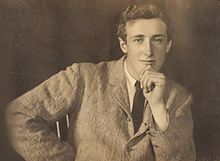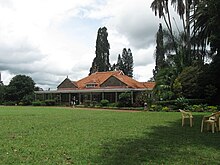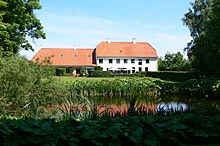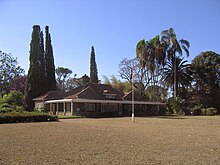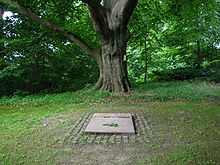Karen Blixen
Karen Christence Blixen-Finecke, born Karen Christentze Dinesen, better known by her pen name Isak Dinesen (Rungsted, April 17, 1885–ibid., September 7, 1962), was a Danish writer.
Childhood
Her father, Wilhelm Dinesen, a military man, a parliamentarian, committed suicide when she was ten years old, tormented by not resisting the pressure of suffering from syphilis, a disease that at that time was stigmatized. Her mother, Ingeborg Westenholz, was left alone with five children in her care, whom she was able to support thanks to her family's help. Karen, like her sisters, was educated in prestigious Swiss schools and raised for the upper classes.
Since she was a child, Karen had artistic inclinations for writing and painting. In 1907 she wrote her first story under the pseudonym Osceola, entitled "The Hermits", which was published in a Danish magazine. She wrote other stories but when she was unable to publish them, she abandoned literature for years.
Trip to Africa
Blixen fell in love with Hans, her second cousin, from a very young age; but he did not reciprocate her and she finally married his brother, Baron Bror Blixen-Finecke, with whom she started a coffee plantation in Kenya called The Karen Coffee Company . difficult. In the first year of their life together, her husband infected her with the dreaded syphilis. He was in Africa before her and had relationships with Maasai, free, nomadic and sick women. He was a healthy carrier. However, the disease never manifested in Karen in a serious way. Tired of the infidelities of her husband, they separated after six years of marriage, leaving her with the plantation.
He learned Aboriginal languages, such as Swahili, and soaked up local customs. The natives nicknamed her "the lioness sister" and she won their affection for her courage, her good marksmanship and her skill as a hunter. Since she arrived in Africa, Karen felt African . her integration into the continent was immediate and her identification with the natives was instant. She saw in the culture of the Africans something very important to learn and share. Her imagination and her skills for oral transmission made Africa her place in the world .
In Nairobi, Blixen met Denys Finch Hatton, a British hunter based in Kenya. They began an intense love relationship, but with many ups and downs.
In 1931, Denys Finch Hatton killed himself in his plane Gipsy Moth. Blixen remained in charge of the plantation until the fall in coffee prices in 1931 forced her to sell it and return to Denmark in August 1931 to live with her mother. She remained on the Rungstedlund family estate for the rest of her life. Her mother died in 1939 and she inherited the family farm. She always thought of going back to Africa but World War II prevented her from doing so.
Her nostalgia for the African land is reflected in a later letter to a neighbor there: “Say my greetings to all those who still remember me, also to the landscape around you, to the forest behind the house where the N`derobo lived, and the old trees gnarled and full of white flowers of the savannah. Also, if you saw any of those animals that in my years we could still find up there, and that I have always thought were the true owners of those lands”.
Although he had already published some works, it was then that he began his literary career under various pseudonyms, the best known of which is Isak Dinesen, with whom he published a series of autobiographical notes on his life in Africa. But it was her book Memories of Africa (1937) that undoubtedly catapulted her to worldwide fame; Inspired by the book, the film homonymous was filmed, starring Meryl Streep in the role of Karen Blixen and Robert Redford as Dennys Finch Hatton.
Life as a writer
While in Kenya, Blixen had written to his brother Tomás: "I have started to do what we brothers and sisters do when we don't know what else to do, I have started to write a book... I have been writing in English because I thought it would be more profitable ". Returning to Denmark, she continued to write seriously. Although her first book, Seven Gothic Tales, was completed in 1933, she had difficulty finding a publisher and used her brother's contacts with Dorothy Canfield to help find a publisher for the book. her work. It was published in the United States in 1934 under the pen name Isak Dinesen, although the publisher refused to give Blixen an advance and had discouraged the use of a pen name. When it was chosen as a Book-of-the-Month Club selection, sales soared. This first book, highly enigmatic and more metaphorical than gothic, won him wide recognition in the United States, and the book's publication in Great Britain. Britain and Denmark followed, albeit with difficulty. Unable to find a translator she was satisfied with, Blixen prepared the Danish versions herself, although they are not translations, but rather close versions of the stories with various different details. Blixen's explanation for the difference was that she, '...wanted it to be published in Danish as an original Danish book, and not in any translation'. Danish critics were enthusiastic about the book and upset, according to Blixen, because it had been first published abroad. Blixen never again published a book in English first. Either her books were first released in Danish, or simultaneously in Danish and English.
Her second book, now her best-known work, Out of Africa, was published in 1937, and its success cemented her reputation as an author. Having learned from her earlier experience, Blixen published the book first in Denmark and England and then in the United States. She was awarded the Tagea Brandt Rejselegat (a Danish award for women in the arts or academic life) in 1939. The work aroused the interest of critics who were concerned not only with the literary evaluation of the book but also with defining the book's own intentions. and morality of Blixen. Postcolonial criticism has linked her with contemporary British writers and in some cases marked her among the morally bankrupt white European aristocrats. Danish scholars tend not to make judgments about her morality, perhaps realizing that while elements of racism and colonial prejudice, given the context and time, are inherent in the work, her position as an outsider, a Dane, and a woman is more complex. Some critics, including Carolyn Martin Shaw and Raoul Granqvist, have considered her a racist and supremacist, while other critics such as Abdul R. JanMohamed acknowledged both her romantic colonial attitudes and her understanding of colonial issues, as well as concern and respect. of it by African nationalists.
Five years after the publication of Out of Africa, Blixen published a collection of short stories called Winter's Tales (1942, Tales of Winter), which made him famous definitively. Based on his previous Gothic works, the stories reflect the harshness of the times, the attitude towards life tinged with courage and pride, and hope for the future. The stories reflect not resistance, but resilience, and explore the interdependence of opposites. He examined shame against pride in "The Heroine", cowardice and courage in "Las Perlas", master-servant relationships in "The Invincible Slavers", and life versus death, as well as freedom versus prison in "Pedro y Rosa". In "Sorrow-acre," the best-known story in the collection, Blixen explored victimization and oppression. Because of the war, she had to get creative to publish the manuscript, travel to Stockholm, and meet with employees of the American and British embassies. The Americans could not send personal items, but the British embassy agreed, sending the document to its publisher in the United States. Blixen received no further communication about Winter's Tales until after the war ended when she received correspondence praising the stories of US troops who had read them in Armed Forces Editions during the conflict.
Blixen then worked on a novel he called Albondocani for many years, hoping to produce a volume in the style of Jules Romains' Les Hommes de Bonne Volunté, with stories intertwined through several volumes. The main character was the caliph Harun al-Rashid, protagonist of the thousand and one nights. In reality, he was simultaneously working on several collections at once, classifying them according to subject matter, whether he thought they were marketable, written primarily to make money, or literary. Almost all of Blixen's short stories from the 1940s and 1950s follow a traditional style of storytelling, weaving gothic themes such as incest and murder with myth and haunting as a means of exploring identity, morality, and philosophy. Most take place in the context of the 19th century or earlier periods. As for his deliberately old-fashioned style, Blixen mentioned in several interviews that he wanted to express a spirit that no longer existed in modern times, that he would rather be than just do. His narratives hover between wishful thinking and romanticism, with keen insight into the preferred tastes of his audience. Blixen crafted her English tales in a more direct manner and her Danish tales in a 19th century writing style that she believed they would like her more. Works written in this period were not published until almost a decade after they were written.
During World War II, when Denmark was occupied by the Germans, Blixen began his only full-length novel, the introspective story The Angelic Avengers, under another pen name, Pierre Andrezel. Although written in Danish, he claimed that it was a translation of a French work written in the interwar period and that he refused to be the author. The book was published in 1944 and nominated for a third Book-of-the-Month Club selection. Blixen initially did not want the book to be nominated, but eventually accepted the award. The horrors experienced by the young heroines were interpreted as an allegory for Nazism, though Blixen also denied that interpretation, claiming instead that it was just a distraction to escape the feeling of being imprisoned by war. In 1956, in an interview for The Paris Review, she finally acknowledged that she was the author, saying that she was her "illegitimate child of hers." Dorothy Canfield described The Angelic Avengers in her Book-of-the-Month News magazine as "of superlatively fine literary quality, written with distinction in exquisite style".
In 1955 he underwent two operations, stomach and spine, and his health was broken; he weighing no more than 35 kilos until his death in 1962.
A collection of short stories, Last Tales (Danish: Sidste fortællinger), was published in 1957, followed the following year by the collection Anecdotes of Destiny (Danish: Skæbne-Anekdoter). Last Tales included seven stories that Blixen intended to be part of Albondocani. It also included sections called New Gothic Tales and New Winter Tales. Blixen's concept of the art of the short story is perhaps most directly expressed in the stories "The Blank Page" and "The Cardinal's First Tale& #34; from his fifth book, Last Tales. These tales illustrate his use of innuendo, which Blixen employed to coerce the reader into participating in the creation of the story. Although he used storytelling techniques, Blixen intertwined obscure references with explicit observations. His writing was not just a storytelling, but a complex layer of clues and double meanings that forced the reader to deduce his intent and draw conclusions.
The writer and academic Javier Marias says of his short stories: "in the midst of that tale of the 20th century (of which someone like Carver is only the culmination or purification, in him there is nothing of a precursor), in the midst of Isak Dinesen's stories, published between 1934 (Seven Gothic Tales) and 1963 (the already posthumous Ehrengard, to which were later added the volumes Carnival, Daguerreotypes and On Modern Marriage, the last two just essays), result in astonishing originality not only because they are deliberately "countable", repeatable, transmittable, but because they try to maintain the immemorial tradition of the tale before that contamination, that of The Thousand and One Nights, to continue with your preference."
Blixen planned Anecdotes of Destiny to be the final part of the Last Tales collection in 1953, but when he had prepared all the stories, he decided to release Anecdotes as a separate volume. The most famous Anecdotes tale is Babette's Feast, about a cook who spends the entire lottery prize of 10,000 francs to prepare a final, gastronomic and spectacular. The story assesses relationships and examines whether the austere but charitable life led by the sisters, in adherence to an ideal, is less true to faith than the passionate gift of her housekeeper's heart. The story was reproduced in a film directed and written by Gabriel Axel in 1987, winning the Academy Award for Best Foreign Film in 1988.
In 1959, Blixen made his only trip to the United States. It was an extended trip that spanned from January to April and while the purpose of his trip was to complete a series of educational and discussion films for the Ford Foundation and the Encyclopedia Britannica, Blixen tried to enjoy it. She starred in a Life magazine feature in the January 19, 1959 issue and attended two Broadway premieres. Blixen was invited to dine with celebrities like Babe Paley and Gloria Vanderbilt. She was photographed by Richard Avedon and Cecil Beaton. She was a guest of John Steinbeck, who organized a cocktail party in her honor; She and she visited by Maria Callas, Nobel Prize laureate Pearl S. Buck and the poets E. M. Cummings and Marianne Moore. When Blixen expressed her desire to meet Marilyn Monroe, author Carson McCullers arranged a meeting with Monroe and her playwright husband, Arthur Miller.
Upon returning to Denmark, Blixen began working despite his serious illness, finishing the African sketches for Shadows on the Grass in 1960. The last of his works published during his lifetime, he it was awarded its fifth selection for Book-of-the-Month. Shadows explores stereotypes and labels of Europeans and Africans, concluding that "prejudices reveal more about the perceiver than the perceived". It consisted of four short stories, "Shadows of the Grass" he focused on his Somali servant Farah; "Faith is revealed", conveys the importance of symbolism; & # 34; The Great Gesture & # 34;, talks about medical issues in his community; and & # 34; Echoes From the Hills & # 34;, in which she assessed his loneliness after leaving Africa and the tireless vigil of his Africa staff kept at the old farmhouse him for many years.
According to an investigation into her illness, by Professor Kaare Weismann, chief medical officer at Bispebjerg hospital, what killed the writer was not an advanced stage of syphilis, but progressive poisoning from the mercury treatments she received in Africa first and Denmark later to curb that venereal disease. Unable to eat, Blixen died in 1962 at Rungstedlund, his family's estate, at the age of 77, apparently of malnutrition. Others attribute her weight loss and her eventual death to anorexia nervosa.
Posthumous works
Works published posthumously by Blixen include: Ehrengard (1962), Carnival: Entertainments and Posthumous Tales (1977), Daguerreotypes and Other Essays (1979) and Letters from Africa, 1914-31 (1981). In the late 1960s, Orson Welles planned an anthology of Dinesen films, in which he intended to release "The Heroine", "The Deluge on Norderney", "A Country Tale" and "Full Moon". After a day of shooting in Budapest for "The Heroine", the project was canceled because its financier went bankrupt. An Immortal Story was adapted and filmed in 1968 by Welles and released simultaneously on French television and in theaters. Welles later attempted to film The Dreamers, but only a few scenes were completed. In 1982, Emidio Greco directed an Italian film, Ehrengard, based on Blixen's play of the same name, which was not released until 2002 due to financial complications.
Legacy
Awards and Honors
For his literary achievements, Blixen was awarded the Danish Holberg Medal in 1949, the Ingenuity et Arti medal in 1950, and was awarded the inaugural Hans Christian Andersen Fellowship of the Danish Writers Association in 1955 and received the Henrik Pontoppidan Grant Memorial Foundation Award in 1959.
In 2012, the Nobel Prize records were made public after 50 years and revealed that the finalists for the 1962 literature prize were John Steinbeck (winner), Robert Graves, Lawrence Durrell, Karen Blixen and Jean Anouilh. Blixen passed away in September, so she could no longer be a candidate, since they are only awarded to living people.
Peter Englund, permanent secretary of the Swedish Academy, called "a mistake" that Blixen was not awarded the Nobel Prize for Literature during the 1930s, and when Hemingway won the prize in 1954, he declared that Bernard Berenson, Carl Sandberg, and Blixen were more deserving of the prize than he was. Although she never received the award, she finished in third place behind Graham Greene in 1961, the year Ivo Andrić was awarded the award.
The former secretary and director of the Blixen household, Clara Svendsen, wrote a book in 1974 entitled Notes on Karen Blixen (Danish: Notater om Karen Blixen), which spoke of the transformation of the young woman who moved to Africa into the sophisticated writer. Giving personal anecdotes about Blixen's life, Svendsen focused on the private woman behind her public image. Anders Westenholz, a nephew of Blixen's, wrote two books about her and her works: Kraftens horn: myte og virkelighed i Karen Blixens liv (1982) (The power of Aries: myth and reality in Karen Blixen's Life) and Den glemte abe: mand og kvinde hos Karen Blixen (1985) (The monkey forgotten: man and woman in Karen Blixen).
Karen Blixen's portrait appeared on the front of the Danish 50 kroner banknote, 1997 series, from May 7, 1999 to August 25, 2005. She also appeared on Danish postage stamps that were issued in 1980 and 1996. Asteroid 3318 Blixen was named in his honor
Rungstedlund Museum
Blixen lived most of her life on the Rungstedlund family estate, which was purchased by her father in 1879. The estate is located in Rungsted, 24 kilometers north of Copenhagen, the capital of Denmark. The oldest parts of the estate date from 1680 and it had functioned as an inn and farm. Most of Blixen's writing was done in Ewald's room, named after the author Johannes Ewald.
In the 1940s, Blixen contemplated selling the property due to running costs, but the house became a haven for a group of young intellectuals, including Thorkild Bjørnvig, Frank Jæger, Erling Schroeder, and others, who found the house as intriguing as its occupant. They began using the property as a literary salon, which continued to be used by artists until 1991. Bjørnvig, who edited Heretica magazine, also developed a close friendship with Blixen. On one occasion Blixen told him, referring to his most intimate nature: & # 34; The difference between you and me is that you have an immortal soul and I don't. This is what happens with mermaids or water fairies, they don't have it either. They live longer than those with an immortal soul, but when they die they disappear completely and leave no trace. But who can entertain and please and enthrall people better than the water fairy when she is present, when she plays and enchants and makes people dance more madly and love more ardently than is ever possible? But she looks, she will disappear, and she just leaves behind a line of water on the ground."
The house was repaired and restored between 1958 and 1960 with a part of the estate set aside as a bird sanctuary at Blixen's own wish. After its restoration, the property was turned over to the Danish Literary Academy and is managed by the Rungstedlund Foundation, founded by Blixen and his brothers. It was opened to the public as a museum in 1991. In 2013 the Karen Blixen Museum joined the Nordic Museum portal. The Karen Blixen Museum displays the rooms in which she lived, which have been preserved as they were when Blixen lived. Shows a gallery of drawings and paintings by Karen Blixen. There is an exhibition of documentaries about her life and work, a bookstore, a projection room, a cafe, a shop and an auditorium used for conferences and special exhibitions.
The house is surrounded by a large park with gardens, where the tomb of the narrator is located, guarded by a hundred-year-old beech tree. The writer was very fond of making very creative bouquets and flower arrangements herself and the museum team has continued her tradition, recreating the same bouquets that she built in life, to decorate the rooms.
Karen Blixen Museum, Nairobi
When Blixen returned to Denmark in 1931, he sold his property to a developer, Remi Martin, who divided the land into 20-acre plots. The Nairobi suburb that emerged on the land where Blixen grew coffee is now called Karen. Blixen herself stated in later writings of hers that "Karen's suburbia" was the only place to be. it was "named after me". The family corporation that owned the Blixen farm became known as the "Karen Coffee Company" and the house she lived in had been built by the chairman of her family business her uncle Aage Westenholz. Although Westenholz named the coffee company after her own daughter Karen and not Blixen, the neighborhood developer named the district after the famous author/farmer rather than after her company.
After changing hands several times, the original country house occupied by Blixen was purchased by the Danish government and given to the Kenyan government in 1964 as an independence gift. The government established a nutrition college on the site and then when the movie Out of Africa was made in 1985, the college was purchased by the National Museums of Kenya. A year later, the Karen Blixen Museum was opened and contains much of Blixen's furniture, which had been repurchased from Lady McMillan, who had bought it when Blixen left Africa.
Others
The Argentine writer Julio Cortázar wrote, in one of his essays, that "we all have a collection of short stories", where "they bind together a reality infinitely vaster than that of his mere anecdote& #3. 4; and why "they last in memory". He included in his (along with other important authors of universal literature, such as Edgar Allan Poe, Guy de Maupassant, Jorge Luis Borges...) the short story "Los soñadores", by Izak Dinesen.
Work
- Bibliography in Open Library OL135127A
- Bibliography in worldcat lccn-no95-3722
Some of Blixen's works were published after his death, including short stories previously withdrawn from earlier collections and essays he wrote for various occasions.
- The Hermits (1907, published in Tilskueren with pseudonimo Osceola)
- The Ploughman (1907) published it in a Danish magazine as Osceola)
- The de Cats Family (1909, published in Tilskueren)
- The Revenge of Truth (1926, published in Denmark)
- Seven Gothic Tales (1934 in the United States 1935 in Denmark)
- Out of Africa (1937 in Denmark and England, 1938 in the United States)
- Winter's Tales (1942)
- The Angelic Avengers (1946)
- Last Tales (1957)
- Anecdotes of Destiny (1958) (including Babette's Feast)
- Memories of Africa (new)#Shadows on the Grass (1960 England and Denmark, 1961 USA)
- Ehrengard (Postum 1963, USA)
- Carnival: Entertainments and Posthumous Tales (Postum 1977, USA)
- Daguerreotypes and Other Essays (Postum 1979, USA)
- On Modern Marriage and Other Observations (Postum 1986, USA)
- Letters from Africa, 1914–1931 (Postum 1981, USA)
- Karen Blixen in Danmark: Breve 1931–1962 (Postum 1996, Denmark)
- Karen Blixen i Afrika. In brevsamling, 1914–31 i IV bind (Postum 2013, Denmark)
Film Adaptations
- An immortal story (The Immortal Story) directed by Orson Welles, 1968.
- Ehrengard led by Emidio Greco, 1982.
- Memories of Âfrica (Out of Africadirected by Sydney Pollack, 1985. He won 7 Oscar, including the best movie, the best director and the best script adapted.
- Babette's feast (Babette's Feast) directed by Gabriel Axel, 1987. It was the first Danish film to win the Oscar to the best non-English film.
Eponymy
- Asteroid (3318) Blixen was named in his honor on his hundredth anniversary.
Quotes
"Human beings suffer a lot. We know many dark hours of doubt, fear and despair, because we cannot reconcile our idea of divinity with what we see in the universe around us. I myself, when I was young, thought a lot about this problem. Later I came to the conviction that we would understand the nature and laws of the universe more clearly and deeply if we accepted from the beginning that its creator and maintainer is a female being. Tales of two old gentlemen .
I had a farm in Africa, at the foot of the Ngong Hills.‘I had a farm in Africa, at the foot of Ngong Hills. ’ Out of Africa, 1937
To be lonely is a state of mind, something completely other than physical solitude; when modern authors rant about the soul's intolerable loneliness, it is only proof of their own intolerable emptiness.‘Being alone is a state of mind, something completely different than physical loneliness; when contemporary authors complain of the unbearable loneliness of the soul, it is only a test of its unbearable void. ‘ Out of Africa, 1937
I know the cure for everything: Salt water...in one form or another: Sweat, tears or the sea.‘I know the cure for everything: salt water... one way or another: sweat, tears or the sea. ‘ The Deluge at Norderney, Seven Gothic Tales, 1934
When in the end, the day came on which I was going away, I learned the strange learning that things can happen which we ourselves cannot possibly imagine, either beforehand, or at the time when they are taking place, or afterwards when we look back on them.‘When the day comes when I have to leave, I will know that there are things that happen that we could never imagine in advance, or at the same time they happen or then when we remember them. ‘ Out of Africa, 1937
He belonged to the olden days, and I have never met another German who has given me so strong an impression of what Imperial Germany was and stood for.‘I belonged to another time and I never met another German who gave me such a strong impression of what the German empire was and represented. ‘About General Paul von Lettow-Vorbeck, German chief commander during the East African campaign. The Great War in Africa
Through all the world there goes one long cry from the heart of the artist: Give me leave to do my utmost!‘At the wide of the world there goes a long cry from the artist’s heart: Let me strive to the maximum!’ "Babette's Feast", 1953
Contenido relacionado
Isaac Asimov
British literature
Loved nerve




